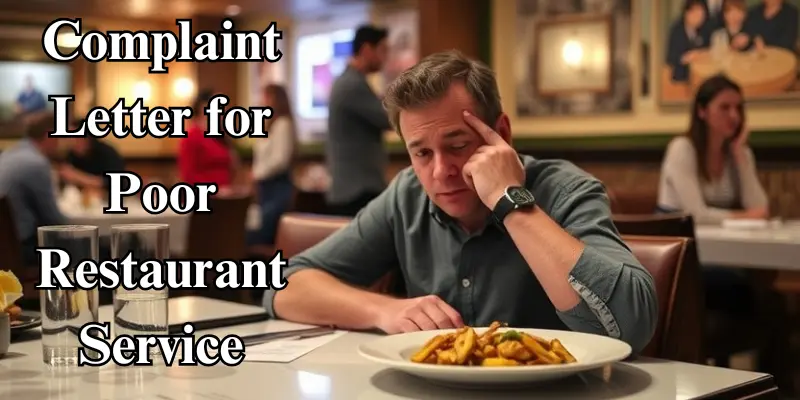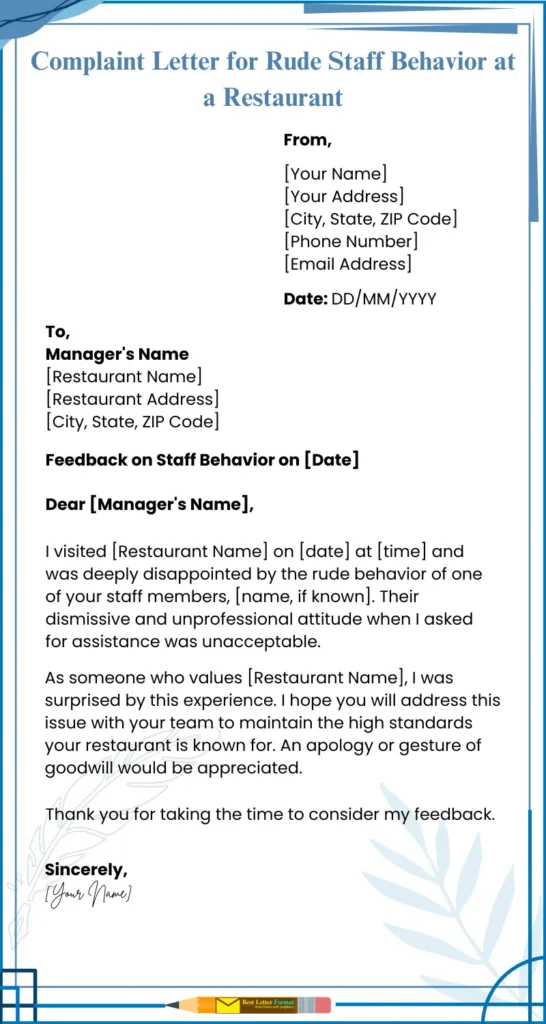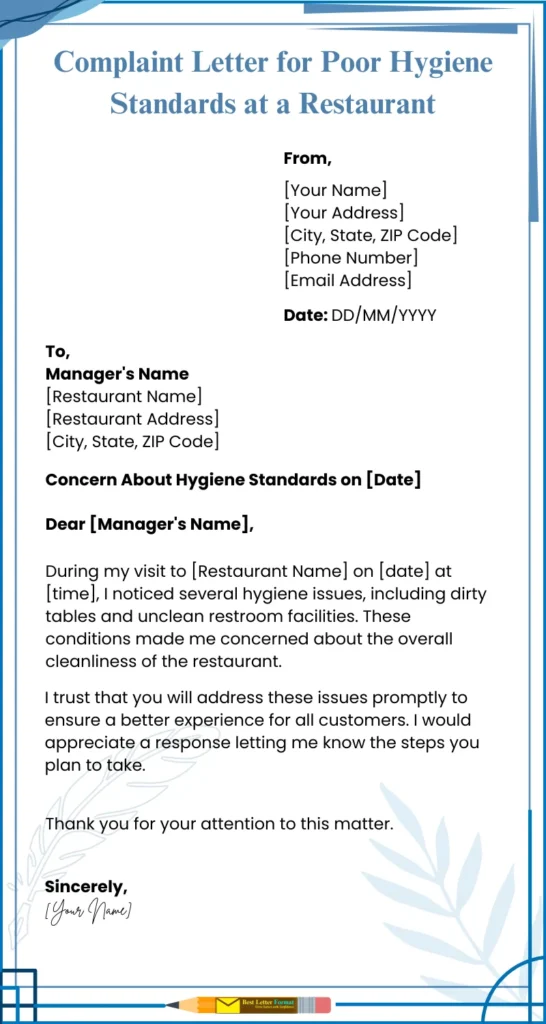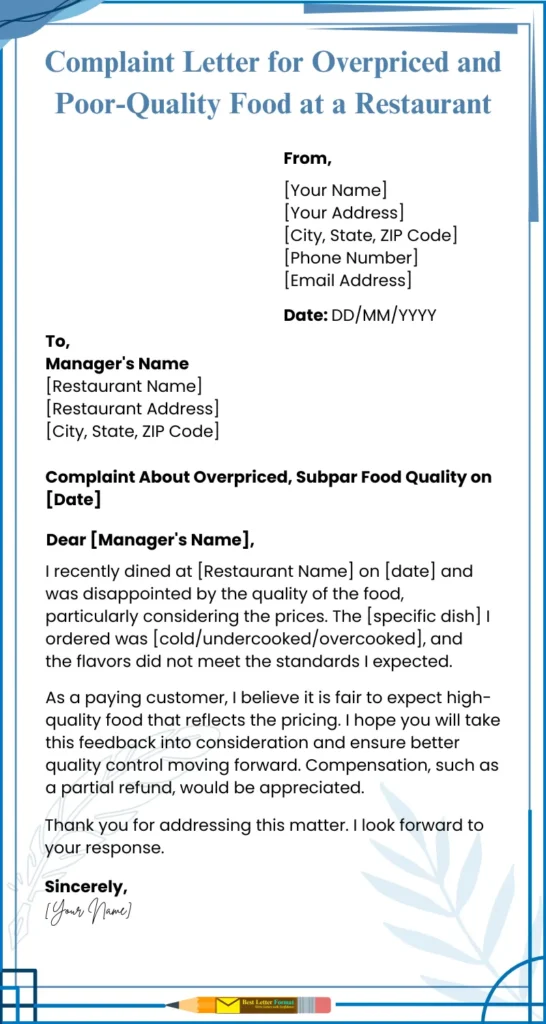Simple Steps to Write a Complaint Letter for Restaurant Issues
Published: 11 Jan 2025
We’ve all experienced it at some point: you head to your favorite restaurant, excited for a delicious meal, only to be met with poor service that leaves you frustrated and disappointed. Whether it’s slow service, unhelpful staff, or incorrect orders, when dining out doesn’t meet your expectations, it can be a real letdown. In these situations, sending a well-written complaint letter can help you express your dissatisfaction, and in some cases, lead to a resolution. But how do you write a complaint letter that’s both professional and impactful?

If you’re unsure where to begin, don’t worry! In this blog post, we’ll guide you through the process of writing a clear, polite, and professional complaint letter for poor service at a restaurant. We’ll also provide a sample template you can personalize to suit your specific situation, and include some tips on making sure your complaint is heard and how to increase the likelihood of receiving a positive response.
Ready to put pen to paper? Let’s dive in!
1. Why Should You Write a Complaint Letter for Poor Service?
Before we dive into the nitty-gritty of writing a complaint letter, let’s first explore why it’s worth your time to do so. Many people feel reluctant to express dissatisfaction directly to a business. However, there are several good reasons why you should go ahead and send a letter when a restaurant’s service doesn’t meet your expectations:
- Feedback Helps Improve Service: Many businesses genuinely want to know when they’ve dropped the ball so they can improve their processes. Your complaint could lead to a better experience for future patrons.
- Compensation or a Resolution: In some cases, a restaurant may offer compensation, such as a discount or a free meal, in exchange for your feedback.
- A Sincere Response: A well-worded letter often garners a response, and it might be the one thing that helps the restaurant realize they’ve made a mistake.
- Avoid Future Disappointments: By sharing your experience, you’re helping the restaurant address systemic issues, ensuring that others don’t face the same problems.
2. How to Write a Complaint Letter for Poor Restaurant Service
Let’s face it—no one enjoys writing a complaint letter. But when your dining experience goes from delightful to disastrous, a well-written letter can turn things around. If you’re unsure how to begin, don’t worry. Follow these straightforward steps, and you’ll have a letter that’s professional, effective, and ensures your voice is heard.
Step 1: Start With Your Details (Make It Easy to Contact You)
At the top of the letter, include your contact details: your name, address, email, and phone number. This helps the restaurant quickly identify you and follow up with a resolution.
Example:
Your Name: Jane Doe
Address: 123 Main Street, Cityville
Email: janedoe@email.com
Phone: (123) 456-7890
Step 2: Add the Recipient’s Details
Next, write the name of the manager or owner (if known), followed by the restaurant’s name and address. If you don’t know the manager’s name, “Dear Manager” works fine.
Example:
- Manager’s Name: [Manager Name]
- Restaurant Name: The Gourmet Spot
- Address: 456 Delicious Lane, Foodtown
Step 3: Insert a Clear and Direct Subject Line
After the recipient’s address, include a subject line that immediately tells the reader why you’re writing. This ensures your letter grabs attention quickly.
Example Subject Lines:
- Subject: Complaint Regarding Poor Service on [Date]
- Subject: Feedback on Dining Experience at [Restaurant Name]
- Subject: Service Issue on [Date]: Request for Resolution
Place this just before the main body of your letter. It’s like a headline for your concerns.
Step 4: Mention When and Where the Problem Happened
Details matter! Include the exact date and time of your visit. This helps the restaurant pinpoint when the issue occurred.
Example:
- “I visited your restaurant, The Gourmet Spot, on Saturday, January 6, 2025, at 7:30 PM. We were seated at Table 14 near the window.”
Step 5: Share What Went Wrong (Be Honest and Clear)
Now it’s time to explain the problem. Focus on the facts and describe what happened. Whether it was slow service, incorrect orders, or rude behavior, make sure your points are clear and concise.
Example:
- We waited 20 minutes to be seated, even though there were empty tables.
- Our server took another 15 minutes to take our order and seemed uninterested in helping.
- When our food arrived, it was cold and did not match what we ordered.
Be polite and avoid exaggeration—your goal is to inform, not to vent.
Step 6: Highlight Your Expectations
Let them know how the service fell short of your expectations. This helps the recipient understand the gap between what you anticipated and what actually happened.
Example:
- “We chose your restaurant for a celebratory dinner, expecting exceptional service and quality food. Unfortunately, the delays and mistakes made the evening frustrating instead of enjoyable.”
Step 7: Politely Request a Resolution
Clearly state what you’d like as a resolution. This could be an apology, a refund, a discount, or even an assurance that corrective measures will be taken. Be reasonable in your request.
Example:
- “I believe a refund for the meal or a voucher for a future visit would be a fair resolution for the inconvenience caused.”
Step 8: End With a Polite and Positive Note
Close your letter by thanking the recipient for their attention and expressing hope that they’ll address your concerns.
Example:
- “Thank you for taking the time to review my concerns. I trust you will take appropriate steps to resolve this issue, and I look forward to your response.”
Step 9: Proofread and Send
Before you send the letter, take a moment to proofread it for typos or errors. A well-written, concise letter shows that you’re serious about your concerns and helps ensure a positive response.
3. Sample Complaint Letters for Poor Restaurant Service
Here are five different complaint letters addressing various scenarios related to poor restaurant service.
Sample 1: Complaint Letter for Incorrect Food Order at a Restaurant
You visited a restaurant and ordered a specific dish with customizations. However, the meal that arrived was entirely different, and the staff made no effort to resolve the issue.
Your Name
[Your Address]
[City, State, ZIP Code]
[Email Address]
[Phone Number]
Date: [Insert Date]
Manager’s Name
[Restaurant Name]
[Restaurant Address]
[City, State, ZIP Code]
Subject: Complaint Regarding Incorrect Order on [Date]
Dear [Manager’s Name],
I visited [Restaurant Name] on [date] and ordered [specific dish with details]. Unfortunately, what was served did not match my order. I brought this to the server’s attention, but no corrective action was taken, leaving me quite disappointed.
As a regular patron, I have always enjoyed dining at your establishment, which is why this experience stood out as unusual. I hope you can review this incident and take steps to ensure better service. I would also appreciate it if you could provide compensation, such as a refund or voucher.
Thank you for your attention. I look forward to hearing from you.
Sincerely,
[Your Name]

Sample 2: Complaint Letter for Long Wait Time at a Restaurant
You arrived at a restaurant with a reservation but experienced excessive wait times for seating, taking the order, and receiving food. The delays disrupted your plans.
Your Name
[Your Address]
[City, State, ZIP Code]
[Email Address]
[Phone Number]
Date: [Insert Date]
Manager’s Name
[Restaurant Name]
[Restaurant Address]
[City, State, ZIP Code]
Subject: Complaint Regarding Long Wait Times on [Date]
Dear [Manager’s Name],
I had a reservation at [Restaurant Name] on [date] at [time], but my dining experience was negatively impacted by significant delays. Despite arriving on time, I waited [duration] to be seated and an additional [duration] for our food to arrive.
While I understand restaurants can have busy periods, the lack of communication and delays were disappointing. I hope you can address this issue to prevent similar experiences in the future. Compensation, such as a gesture of goodwill, would also be appreciated.
Thank you for your attention to this matter.
Sincerely,
[Your Name]

Sample 3: Complaint Letter for Rude Staff Behavior at a Restaurant
During your visit to a restaurant, a staff member spoke to you rudely and made no effort to provide proper service. The behavior left you feeling disrespected and unwelcome.
Your Name
[Your Address]
[City, State, ZIP Code]
[Email Address]
[Phone Number]
Date: [Insert Date]
Manager’s Name
[Restaurant Name]
[Restaurant Address]
[City, State, ZIP Code]
Subject: Feedback on Staff Behavior on [Date]
Dear [Manager’s Name],
I visited [Restaurant Name] on [date] at [time] and was deeply disappointed by the rude behavior of one of your staff members, [name, if known]. Their dismissive and unprofessional attitude when I asked for assistance was unacceptable.
As someone who values [Restaurant Name], I was surprised by this experience. I hope you will address this issue with your team to maintain the high standards your restaurant is known for. An apology or gesture of goodwill would be appreciated.
Thank you for taking the time to consider my feedback.
Sincerely,
[Your Name]

Sample 4: Complaint Letter for Poor Hygiene Standards at a Restaurant
You noticed poor hygiene at the restaurant, including dirty tables and restrooms, which made you question the establishment’s cleanliness practices.
Your Name
[Your Address]
[City, State, ZIP Code]
[Email Address]
[Phone Number]
Date: [Insert Date]
Manager’s Name
[Restaurant Name]
[Restaurant Address]
[City, State, ZIP Code]
Subject: Concern About Hygiene Standards on [Date]
Dear [Manager’s Name],
During my visit to [Restaurant Name] on [date] at [time], I noticed several hygiene issues, including dirty tables and unclean restroom facilities. These conditions made me concerned about the overall cleanliness of the restaurant.
I trust that you will address these issues promptly to ensure a better experience for all customers. I would appreciate a response letting me know the steps you plan to take.
Thank you for your attention to this matter.
Sincerely,
[Your Name]

Sample 5: Complaint Letter for Overpriced and Poor-Quality Food at a Restaurant
You were charged a high price for a meal, but the quality of the food did not meet expectations. This left you feeling that the experience wasn’t worth the cost.
Your Name
[Your Address]
[City, State, ZIP Code]
[Email Address]
[Phone Number]
Date: [Insert Date]
Manager’s Name
[Restaurant Name]
[Restaurant Address]
[City, State, ZIP Code]
Subject: Complaint About Overpriced, Subpar Food Quality on [Date]
Dear [Manager’s Name],
I recently dined at [Restaurant Name] on [date] and was disappointed by the quality of the food, particularly considering the prices. The [specific dish] I ordered was [cold/undercooked/overcooked], and the flavors did not meet the standards I expected.
As a paying customer, I believe it is fair to expect high-quality food that reflects the pricing. I hope you will take this feedback into consideration and ensure better quality control moving forward. Compensation, such as a partial refund, would be appreciated.
Thank you for addressing this matter. I look forward to your response.
Sincerely,
[Your Name]

4. How to Send a Complaint Letter to a Restaurant: Email vs. Handwritten Letter
When it comes to addressing poor restaurant service, choosing the right method to send your complaint letter can make a big difference. Should you email it for a quick response? Or go the traditional route with a handwritten letter for a more personal touch? Let’s dive into both options so you can decide what works best for you and make sure your complaint gets noticed.
If You’re Sending an Email: Keep It Quick and Clear
Emails are perfect for fast communication. Most restaurants are responsive to emails because it’s easy for them to reply quickly. Here’s what you need to keep in mind:
1. Use a Catchy Subject Line
The subject line is your letter’s first impression. Make it direct so the manager knows why you’re writing.
Example:
- Subject: Urgent Feedback on My Visit to [Restaurant Name]
- Subject: Concern About Poor Service on [Date]
2. Keep the Tone Polite
Even if you’re upset, maintain a respectful tone. Your goal is to get a resolution, not to vent frustrations.
3. Be Concise
Restaurants are busy. Stick to the key points: what happened, when, and what you’d like them to do about it. No long stories!
4. Attach Supporting Evidence
If you have photos of incorrect dishes, receipts, or anything that supports your claim, attach them to the email. Evidence adds credibility.
5. Include Contact Information
Don’t forget to include your name, phone number, and email so they can respond. If you’re expecting compensation, they’ll need these details.
If You’re Writing a Handwritten Letter: Add a Personal Touch
Handwritten letters might take longer, but they show that you’ve gone the extra mile. Restaurants often appreciate this effort and may take your concerns more seriously. Here’s how to make it work:
1. Start with Neatness
Use clean, good-quality paper. Nobody wants to read a letter that looks like it was scribbled in a hurry.
2. Follow a Formal Format
Include your full name, address, and the date at the top of the letter. This gives it a professional structure.
3. Write Clearly and Legibly
Use your best handwriting (yes, this matters!) or print neatly. A hard-to-read letter might not get the attention it deserves.
4. Focus on the Key Details
Describe the issue and include details like the date, time, and specifics of what went wrong. Be respectful and constructive—avoid ranting.
5. Drop It Off in Person (Optional)
Hand-delivering your letter to the restaurant manager can make a big impact. It shows that you care about the issue and are serious about resolving it.
Which Option Should You Choose?
Both email and handwritten letters have their strengths. If you need a quick response, go with email. If you want to make a lasting impression, a handwritten letter might be your best bet. Either way, the most important thing is to ensure your message is clear, polite, and constructive.
Pro Tip: No matter which method you choose, keep a copy of your complaint for your records. This is especially useful if you need to follow up later.
5. Simple Tips for Writing a Complaint Letter to a Restaurant
Writing a complaint letter to a restaurant can be simple and effective. Use these bullet points to ensure your message is clear and gets the attention it deserves:
- Be Polite:
Stay calm and respectful, even if you’re upset. A polite tone makes it more likely that the restaurant will take your complaint seriously. - Include the Basics:
Mention your name, the date and time of your visit, and the restaurant’s name. These details help them locate the incident quickly. - Be Specific About the Problem:
Clearly describe what went wrong. Stick to the facts—whether it’s slow service, cold food, or cleanliness issues. - Suggest a Solution:
Let the restaurant know how they can make things right. Whether it’s an apology, a refund, or a promise to improve, be clear about what you expect. - End on a Positive Note:
Finish your letter politely and positively. This shows that you’re open to resolution and leaves a good impression. - Keep It Short:
Don’t over-explain. A short and concise letter is more likely to be read and addressed. - Proofread Before Sending:
Double-check your letter for mistakes. A clear and error-free letter shows you’re serious and professional.
6. Top 10 Restaurant Complaints Diners Commonly Face
Complaints are a natural part of the dining experience and can happen at any restaurant. Identifying these common complaints can help improve customer satisfaction and create better dining experiences. Here’s a list of the most frequent complaints diners make:
- Poor Customer Service
- Rude or inattentive staff.
- Delays in taking orders or delivering food.
- Lack of knowledge about the menu.
- Incorrect or Missing Orders
- Receiving the wrong dish.
- Missing items from the order.
- Lack of attention to special requests or dietary needs.
- Long Waiting Times
- Delays in being seated.
- Extended wait times for food or drinks.
- Poor communication about delays.
- Food Quality Issues
- Meals served cold or undercooked.
- Use of stale or low-quality ingredients.
- Flavors not meeting expectations.
- Overpricing or Poor Value for Money
- High prices not matching the food or service quality.
- Small portion sizes or overpriced menu items.
- Hidden charges or unclear billing.
- Hygiene and Cleanliness Concerns
- Dirty tables, utensils, or serving areas.
- Poorly maintained restrooms.
- Visible hygiene issues in the kitchen or dining area.
- Uncomfortable Atmosphere
- Excessive noise from music or other diners.
- Cramped seating or poor table arrangements.
- Inadequate lighting or temperature control.
- Miscommunication with Staff
- Errors due to unclear communication.
- Staff misunderstanding customer needs or requests.
- Lack of response to questions or concerns.
FAQs About Writing a Complaint Letter for Poor Restaurant Service
Here’s a list of frequently asked questions (FAQs) to help you better understand how to write an effective complaint letter for poor restaurant service.
Writing a complaint letter helps you share your concerns with the restaurant, seek a resolution, and potentially improve their service for future diners.
Always include your name, contact information, the date and time of your visit, and specific details about the issue you experienced.
Use respectful language, stay calm, and focus on the facts rather than venting frustration. Politeness increases the chances of getting a positive response.
Yes, if appropriate. Be clear about what you’d like, whether it’s a refund, a discount, or an apology, but keep your request reasonable.
Both options work. Email is faster, while a handwritten letter adds a personal touch. Choose the method that suits your situation best.
Avoid being overly emotional, using rude language, or making your letter too long. Stick to the key points and be respectful.
Keep it short and to the point—usually one page is enough to explain the issue and suggest a resolution.
Yes, attaching evidence like photos or receipts adds credibility to your complaint and helps the restaurant understand the issue better.
Most restaurants respond within a week or two. If you don’t hear back, consider following up politely to check on your complaint.
If the restaurant doesn’t respond or resolve your issue, you can leave a constructive review online or escalate your complaint to a higher authority, like the company’s head office.
Conclusion
Dealing with poor restaurant service can be a frustrating experience, but writing a thoughtful complaint letter is a great way to make your concerns heard. It not only helps you seek a resolution but also gives the restaurant a chance to improve.
Here’s a quick recap of what we discussed:
- Why Write a Complaint Letter: To share your feedback, get a resolution, and improve future experiences.
- How to Write the Letter: Be clear, polite, and include all the important details.
- Helpful Templates and Tips: Use our examples and stay concise and respectful.
- Common Complaints at Restaurants: From poor service to hygiene issues, you’re not alone in facing these problems.
Did this guide help you? Have you ever written a complaint letter before, or do you plan to now? Let us know! And if you found this article useful, share it with someone who might need it.
Your feedback is important to us, and we’re here to help you make dining experiences better.

- Be Respectful
- Stay Relevant
- Stay Positive
- True Feedback
- Encourage Discussion
- Avoid Spamming
- No Fake News
- Don't Copy-Paste
- No Personal Attacks

- Be Respectful
- Stay Relevant
- Stay Positive
- True Feedback
- Encourage Discussion
- Avoid Spamming
- No Fake News
- Don't Copy-Paste
- No Personal Attacks








